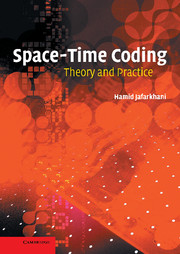Book contents
- Frontmatter
- Contents
- Preface
- Standard notation
- Space-time coding notation
- List of abbreviations
- 1 Introduction
- 2 Capacity of multiple-input multiple-output channels
- 3 Space-time code design criteria
- 4 Orthogonal space-time block codes
- 5 Quasi-orthogonal space-time block codes
- 6 Space-time trellis codes
- 7 Super-orthogonal space-time trellis codes
- 8 Differential space-time modulation
- 9 Spatial multiplexing and receiver design
- 10 Non-orthogonal space-time block codes
- 11 Additional topics in space-time coding
- References
- Index
10 - Non-orthogonal space-time block codes
Published online by Cambridge University Press: 14 August 2009
- Frontmatter
- Contents
- Preface
- Standard notation
- Space-time coding notation
- List of abbreviations
- 1 Introduction
- 2 Capacity of multiple-input multiple-output channels
- 3 Space-time code design criteria
- 4 Orthogonal space-time block codes
- 5 Quasi-orthogonal space-time block codes
- 6 Space-time trellis codes
- 7 Super-orthogonal space-time trellis codes
- 8 Differential space-time modulation
- 9 Spatial multiplexing and receiver design
- 10 Non-orthogonal space-time block codes
- 11 Additional topics in space-time coding
- References
- Index
Summary
Introduction
We introduced space-time block coding in Chapter 4. The space-time block codes in Chapters 4 and 5 have interesting structures that can be utilized to simplify the ML decoding. The orthogonality of OSTBCs makes it possible to decouple the decoding of different symbols. Similarly, a pairwise decoding is possible for QOSTBCs. Such simple ML decoding methods restrict the cardinality of transmitted symbols. It may also impose a limit on the performance of the code. On the other hand, there is no restriction on the number of receive antennas and even one receive antenna is enough. In addition to simple ML decoding and full diversity, the nice structure of these codes makes it possible to combine them with other blocks of the system. In fact, the transmission of an orthogonal STBC over a MIMO channel usually translates into N parallel SISO channels. As a result many wireless communication methods and building blocks that have been developed for SISO channels can be easily generalized using an orthogonal STBC. In many wireless communication systems the above advantages and disadvantages makes OSTBC a very attractive candidate, especially at low transmission bit rates.
As discussed in Chapter 4, OSTBCs are more restrictive for channels with higher number of antennas. When decoding complexity is not an issue, one may design codes that provide higher rates or better performance compared to OSTBCs.
- Type
- Chapter
- Information
- Space-Time CodingTheory and Practice, pp. 251 - 271Publisher: Cambridge University PressPrint publication year: 2005



